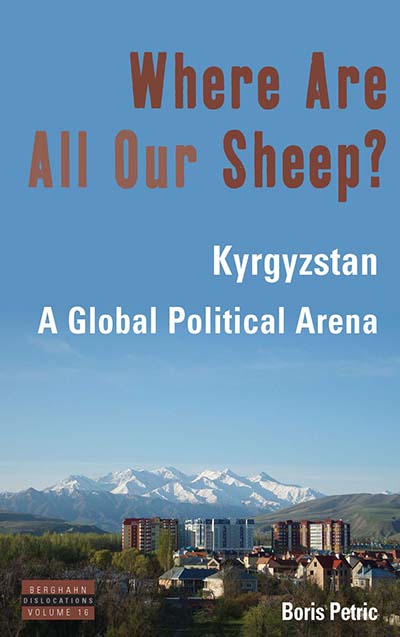Home -> Title

Contents
Acknowledgements
Map of Central Asia
Map of Kyrgyzstan
Introduction: Someone Ate All Our Sheep
- On the Kyrgyz Highlands
- In Search of a Baseline
- Looking Back on a Soviet Economy of Intensive Livestock Farming
- From Kolkhoz to Village
- The Anthropologist in the Face of Social Change
-
Some Local Authority Figures
- The Former Kolkhoz Chairman: The Bashkarma
- The New Official Local Authority: The Ayil Okmotu
- The “Biznesman”: Economic Power
- The Shepherd: A Prestigious but Powerless Figure
- The Moldo or the Affirmation of Religious Authority
- The Rise of NGOs and the Development of Private Enterprise
- Logics of Power: Appropriation, Plunder, and Capture of Resources
Chapter 1. Manas, Unesco, and the Kyrgyz Fabula
-
Manas: Political Uses of a Traditional Oral Epic
- Indigenization and Nationalization of the Epic
- Manas 1000: Political Ritual of the New Kyrgyz Identity
- Manas Gumbez: A National Heritage Site
- Manas Ayili and the Building of an International Image
- UNESCO: Global Entrepreneur of the Kyrgyz National Imaginary
- Polysemous Perceptions of the Creation of the New National Imaginary
- Democracy, Decentralization, Tribal Identity, and Minorities
- Affirmation of Ethnic Identity in the South of the Country
- Enhancing “Tribal” Identity in the North
- Manas in a Context of Globalization
Chapter 2. Kyrgyzstan and Good Governance Experts
- The Ideology of Good Governance: Minimal Government, Private Enterprise and Civil Society
- The UNPD: Decline of the State, Promotion of Local and Traditional Political Practices
- From an Economic Planning Culture to a Project Culture
- Promoting Democracy
- The Development of Local Kyrgyz NGOs
- Electoral Assistance: Technical Aid or Political Interference
Chapter 3. Elections and the Promotion of Democracy
- Ethnography of an Election
- IFES and Elections: Democracy@large
- Ethnography of an American Political Foundation Training Session
-
Training and Strategy of Influence
- Eligibility: The Demokrat and Kyrgyzness
Chapter 4. The Fall of the Common House
- The Soviet Regime or the Ambition to Establish Absolute Control over Human Flows
- Askar Akayev’s Common House Ideology and Emigration of the Russian-Speaking Population
- Rural Exodus and Urban Sprawl
- From Migration to Increased Kyrgyz Mobility
- The Russian Perspective: Gastarbeiter
- The Political Weight of Remittances in Kyrgyzstan
Chapter 5. The Bazaar: Symbol of a Society of Traders
- The Bazaar: The Return to a Natural Economic Order?
- The “Bazarkoms”: New Social Figures
-
Property and Political Protection: The Dordoy Bazaar and Askar Salymbekov
- From Dordoy Bazar to Dordoy Associatsia: The Transmission of Capital
- Patronage and Political Clientele
- Redistribution and Social Legitimacy
- Soccer and Kok-boru
- Giving to the Dead and to God: Monuments and Jubilees
- The Changing Face of the Bazaar: The Labor Market on Avenue Maladoja Guardia
Chapter 6. Civil Society and Election Monitoring
- Koalitsia and the National Democratic Institute
- Baisalov: Portrait of a Democracy Promotion Icon
- Koalitsia and the ENEMO Transnational Network
- Intellectual Influences: Non-Violent Movements
- Koalitsia’s Hour of Glory: The Tulip Revolution
- Participative Observation in an Election Mission
- The Election Mission: A Multi-camp Caravan
- The Deployment of Observers
- Return to the Capital and Debriefing
- The Press Conference
- Cocktail Hour: The Communion Ritual of Democracy Promoters
- Communion of Contentious Actors: Opposition Coalition, Koalitsia, and Kel-Kel
Chapter 7. The Transnationalization of Politics
- Anthropology of a Fraudulent Election
- Electoral Observation and Local Dynamics
- A Changing Political Personnel: From Appointees to Elected Officials
- Becoming a Deputat: An Exemplary Political Battle
- Political Transhumance, Opposition, Marginalization, and Exile
- Political Practices and Regional Factionalism
- The New Role of the President and Appointed Political Personnel
- From Communism to Keminism
- From Keminism to Teyitism
- The Political Change in 2005: Revolution, Overthrow, or Coup?
Conclusion: The Kyrgyz Laboratory and the Global Politics
Afterword: From the Kyrgyz Fabula to the Ethnic Apocalypse?
Appendix I: Kyrgyz Republic Timeline
Appendix II: Census of Kyrgyzstan Population
Index
Where Are All Our Sheep?
Kyrgyzstan, A Global Political Arena
Boris Petric
Translated from the French by Cynthia Schoch
186 pages, 2 illus., bibliog., index
ISBN 978-1-78238-783-1 Hb Published (September 2015)
eISBN 978-1-78238-784-8 eBook

